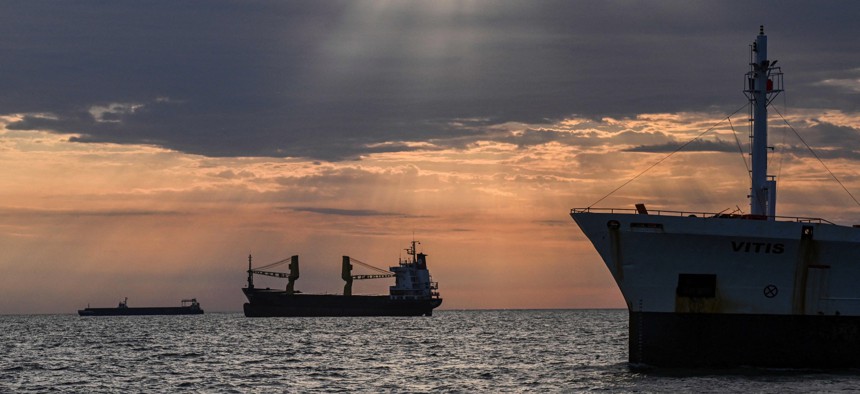
Ships anchored in the Black Sea await to enter the Sulina canal, one of the spilling points of the river Danube to the Black Sea in Sulina, southeastern Romania, on June 8, 2022. Photo by DANIEL MIHAILESCU/AFP via Getty Images
The Danube Won’t Solve Ukraine’s Grain Problems
Europe’s second-longest river isn’t deep enough to carry ocean-going grain vessels.
Negotiations between Russia and Ukraine about safe passage for Ukrainian grain through the Black Sea are said to be making progress. But even if the parties do reach an agreement, the grain will be going nowhere without shipping companies and their insurers – and only a few will risk the maritime journey under such conditions. That’s what makes the newly available Danube River route so attractive. Unfortunately, the Danube option is less clever than it sounds.
The negotiations between Russia and Ukraine, facilitated by Turkey and the United Nations, could lead to an agreement as early as next week. According to Turkey’s defense minister, Hulusi Akar, the deal will include joint controls for port checks of cargo and Turkish guarantees of the shipments as they traverse the Black Sea. As part of the deal, Russia, Ukraine, and the United Nations would also work together through a grain coordination center set up by Turkey, Reuters reports.
This progress is excellent news, – but a lot could happen before the deal is signed, and indeed after it’s signed. As a backup, the global community is pinning its hopes on the Danube, which is navigable from its mouth on Ukraine’s Black Sea coast through Romania, Hungary, and other EU member states to Germany. With Ukraine having recaptured Snake Island near the Danube’s entry, the famous river — which travels through Romania, Hungary, and other EU member states before ending in Germany — is, for now,indeed a safe option for Ukrainian grain. Ukrainian authorities are already reactivating the previously sleepy river port of Reni, which is located about 100 miles [PB2] upriver from the Black Sea and hasn’t been in use since Soviet times. At the time of writing, some 160 vessels are waiting to enter the Danube from the Black Sea.
But Tthe Danube, alas, won’t solve the global hunger crisis caused by Russia’s invasion. Indeed, the river passage is a less clever solution than the global community seems to think. This is because ocean-faring vessels of the kind that typically travel through the Black Sea are too big for river transport. Ukraine’s leading Black Sea Shipping Company, for example, operates Volzhskiy-class cargo ships, which need a minimum water level of 360 centimeters. The Danube, though, has passages that can only be traversed by ships requiring water levels of 150 centimeters. Many of the Black Sea Shipping Company’s other ships are also too big to sail through the Danube.
They could, of course, make an early stop in Romanian ports that conveniently don’t feature low-water level bottlenecks. Indeed, Romania has made its Constanta port available for Ukrainian grain. But like all infrastructure, ports can’t suddenly leap from one level of activity to a much higher one: they need additional staff, not to mention additional storage facilities.
“If we want to keep helping Ukrainian farmers, we need help to increase our handling capacities,” said Dan Dolghin, director of cereal operations at the Port of Constanta, told Voice of America last month. “No single operator can invest in infrastructure that will become redundant once the war ends.,” he added.
The considerable challenges of transporting Ukrainian grain through the Danube rather than the Black Sea mean that the shipments will return to the Black Sea the moment the war ends and shipping companies and their insurers consider the Sea safe enough. As things stand, out of the 25 million tonnes of grain needing to be exported since Russia invaded Ukraine, 5 million tonnes have been exported via roads, rail and, or river routes. Last month, Ukraine managed to export 2.5 million tonnes, up from 200,000 tonnes in March – but far less than the 5 million tonnes it previously exported every month.
Then there’s the most obvious complication: the Danube leads through Romania and Hungary to Austria and Germany, while the grains need to travel to Africa and the Middle East. That means that even the relatively small amounts of grain that will be able to travel up the river to suitable ports is making a significant detour from its intended journey, and thus incurring additional costs that neither the senders nor the recipients can afford.
That doesn’t mean that the Danube option should be dismissed: on the contrary, every tonne of grain that reaches hungry stomachs is worth the effort. It does mean, though, that the Danube is a less clever option than it may seem. The only way of getting enough grain to the stomachs that need it is through the Black Sea, which is why the Turkey-mediated talks between Russia and Ukraine are so important.
What would Russia get out of agreeing to a maritime corridor for Ukrainian grain when it can put pressure on the whole world by blocking the grain? Enormous good will from countries rich and poor. Especially the countries that may have supported Russia at the early stages of the war— – often developing countries with Cold War links to the then-Soviet Union —– have been hit hard by the grain shortage. Even if it wanted, Russia wouldn’t be able to steal enough Ukrainian grain to supply them all. In Sri Lanka, President Gotabaya Rajapaksa has already had to resign after massive protests over fuel and food shortages.
It’s good that we have the Danube. But though the famous river is a long-standing workhorse of European transportation, it’s not going to solve the global problem created by Russia’s invasion of Ukraine.





